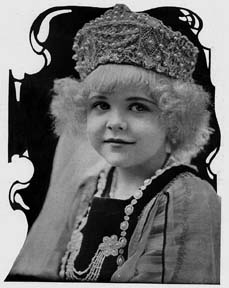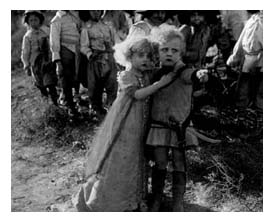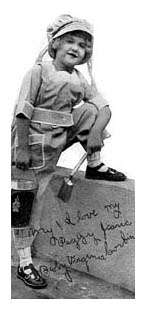 October,
1916, and would have turned six in December of that year, yet
all of the publicity referred to her as four years old.
October,
1916, and would have turned six in December of that year, yet
all of the publicity referred to her as four years old.
A Fox ad from the time mentions studios she had previously been associated with. In the article that quoted Ellen Beach Yaw as having discovered Virginia, Ms. Yaw says she got her a job at Pathé Fréres, and, from there, Virginia went to Mack Sennett and then Fox. However, neither Sennett nor Pathé Fréres are mentioned in the Fox ad.
It reads,
"Baby Virginia Corbin, Youngest Emotional Star, Now playing
lead in Fox Film Company special production directed by C.M. and
S.A. Franklin has been featured in leads only by Universal, Metro,
Balboa, Fox."
Virginia's parents were apparently continuing
to "fudge" on her age. She signed with Fox in  October,
1916, and would have turned six in December of that year, yet
all of the publicity referred to her as four years old.
October,
1916, and would have turned six in December of that year, yet
all of the publicity referred to her as four years old.
One of the articles that gives Virginia's age as four claims the new little star had an interesting heritage. "Baby Virginia Corbin, Fox's four-year old emotional star, has just received an ancient necklace from her grandfather in Philadelphia, Lyman Jerome Corbin, which embodies a finely-executed coat-of-arms of the Corbin family and bears the date of 1015. This coat-of-arms has been handed down from ancestors of the present Corbins from generation to generation for nearly one thousand years. It was worn by the first Corbin who came from France to England with William the Conqueror, and who was knighted on the battlefield at Windsor, and has been worn by diplomats and many distinguished members of the family since that date."
Fox was no doubt promoting its little star in a big way, and the above story may or may not have been fabricated by the studio's publicity department. None of the family seems to know of the whereabouts of the necklace today.
In 1917, Fox made four fairy tale Kiddie Features, all directed by brothers C.M. and S.A. Franklin - "Jack and the Beanstalk," "Aladdin and His Wonderful Lamp," "Treasure Island," and "Babes in the Woods." Francis Carpenter was her co-star in each of these which also featured child stars Carmen De Rue and Violet Radcliffe (who usually played a male part, most often the "bad guy").
The first of these, "Jack and the Beanstalk" (sometimes referred to as "A Modern Jack and the Bean Stalk") was released in July, 1917, to rave reviews. One account noted, "This picture play marks the beginning of a new era in the picturization of fairy tales. What 'The Birth of a Nation' was to adult photo drama, marking its advance, 'Jack and the Bean Stalk' is to the youngsters. It is the kids' 'Intolerance,' 'Spoilers,' 'Cabiria' and 'Wild and Wooly' all rolled into one."
Another said, "'Jack and the Bean Stalk'
. . . opened at Miller's theater on Sunday just two weeks after
it began a ten weeks' engagement at the Globe theater on Broadway,
New York, and was received by the audience and the newspaper critics
among it with impressive  enthusiasm.
The critics were unanimous in lauding the picture as a remarkable
novelty in the silent drama." While on Broadway, the movie
was reportedly playing "at dollar prices."
enthusiasm.
The critics were unanimous in lauding the picture as a remarkable
novelty in the silent drama." While on Broadway, the movie
was reportedly playing "at dollar prices."
As Princess Regina, Virginia was singled out for high praise, as well. "The acting of Virginia . . . in her love scenes with Jack, who has come to slay the giant, is simply way ahead of anything that any other child ever had accomplished. It is interesting to note that various accounts of the movie indicate its cost as $30,000, $300,000, $500,000 and even $800,000, such was the studio publicity of the day.
"Aladdin and the Wonderful Lamp" was released in Oct., 1917. Apparently Fox tried to outdo the success of "Jack and the Bean Stalk" as the "Aladdin" production was described as "a gorgeous one and is rich in cleverly devised 'bits.' There are also many fine spectacular effects, wonderful Oriental atmosphere, colorful costumes and scenes of dashing horsemen on the desert." This film survives today in a somewhat abbreviated form.
"Babes in the Woods" is the second of the Fox Kiddie Features to have survived. Of her performance in this film, one review noted, "Virginia Lee Corbin, the dainty maiden who can weep to order and continue indefinitely, is tragically charming . . ."
One scene called for the little princess (Virginia) to sail out to sea toward "the misty land of dreams" on the back of a lovely swan. A huge, stuffed swan was mounted on a float and launched in the water. In order to test it, the director asked several of the young boys in the cast if they would volunteer as the trial passenger, but each refused. Supposedly, Virginia cried, "I'll ride it!" She did, however, a wire attached to the swan broke with Virginia drifting away from shore and toward the rapids further downstream. Unfortunately, no boat was available. Just as the company began to panic, Virginia reportedly kept her head, put her legs down and kicked the water vigorously until she was near enough to the shore to catch a rope that had been thrown her way.
Approximately six years old at the time the film was made, Virginia does a heart-rending peformance of a little girl, along with her brother, whose stepmother and brother hire "bad men" to take them to the forest and kill them. (Much of the film was shot in the Big Redwoods near Santa Cruz.) Virginia's tears and the terror on her face are convincing when these men come and abduct her and her brother from their home. As a matter of fact, she has several opportunities to let the tears flow in this film. It is no wonder Fox billed her as the "Youngest Emotional Star."
Another "title" that was bestowed on Virginia around this time was "The Dresden Doll of the Movies." One interviewer visited the set of "Babes in the Woods" and wrote, "Yesterday out at the powder mill site the social editor met this doting mother and her daughter, called the 'Dresden doll of the movies.' That's better than any name I could think of, because it really just suits her. Her pretty little doll face is so perfect that you hope she'll never, never grow older. A slender little figure, with a stateliness derived, perhaps, from her English-French ancestry, which is fascinating, supports her flower-like face."
One reviewer noted, ". . . her directors. . . declare that she is the most wonderful child they have ever directed. Miss Corbin is a remarkable little emotional actress and her ability to shed tears is considered marvelous for she does not 'act,' but is just as natural and unaffected as her parents could wish for and does not realize the value of her work."
Critic Alan Dale of the New York American said of Virginia and Francis Carpenter, "None of the proud movie stars at colossal salaries can hold a candle to these wonderful actors."
Apparently Fox saw the commercial possibilities in his little "emotional star" after the success of "Jack and the Beanstalk" and signed Virginia to a contract. Accounts different as to its details, but it appears to have been for anything from one year to five years and $75 to $175 a week. Around this time, a suit was brought against Virginia and her parents by Don Meaney and Ed Roberts who claimed to have secured Virginia a contract with Fox for $75 a week but never were paid a commission. A brief article on the suit said Fox had since signed a two-year contract with the child running from $100 to $175 a week. It makes no mention of the outcome of the suit.
One article that referred to a "five-year
contract," said, "The salaries which these youngsters
(Virginia and Francis Carpenter) will draw will not only support
themselves and their parents in luxury, but will enable each of them to have substantial bank
accounts before either of them is ten years old." It goes
on to say that an automobile is also included in their contracts.
of them to have substantial bank
accounts before either of them is ten years old." It goes
on to say that an automobile is also included in their contracts.
Commercial interests saw the value of having movie stars endorse their products even in these early years, and Virginia, due to her popularity, was not exempt. Advertisements show her endorsing Palmer cord tires and Peggy Jeans for Kiddies.
During this time, Virginia, as well as the other children, were being treated "royally" by the Fox company. On the studio lot they were provided a private bed, individual dressing rooms, play rooms, a gymnasium, baths, a swimming pool and a rest room. (A photo of the rest room shows Virginia and four other children seated around a small white table. In the room is a small bed, a dressing table, a hobby horse and various other books and toys.) The children also were provided schooling from 8-10 a.m. and 3-5 p.m. with a licensed teacher and overseen by the Los Angeles school board,
"Treasure Island" was the fourth of the Fox Kiddie features and was released in Jan., 1918. (This film was probably the third in the series and made before "Babes in the Wood" since it was originally scheduled for a Nov., 1917, release. An order from the fuel administrator to close all industrial establishments for five days affected the Fox film printing plant and caused the delay.) Not much is known about the picture except it was described as having "considerable more emphasis on humor than in the previous pictures."
After "Treasure Island," Virginia made "Six-Shooter Andy" and "Ace High," both 1918 and both with Tom Mix. "Fan Fan" that same year was apparently a return to the Kiddie Features with the same cast of youngsters. This would be an interesting film to see today, because in it, Carpenter is Hanki Pan, the Japanese emporer's son, and Virginia is Fan Fan, the girl Hanki Pan plans to marry. Carmen De Rue plays Lady Shoo, "an ugly hag." The story has Hanki Pan and Fan Fan eloping and being pursued by Lady Shoo and Fan Fan's rejected suitor, the Chief Executioner.
Virginia's last film for Fox was the 1919 drama "The Forbidden Room" with Gladys Brockwell. From the description, it appears Virginia's part was small, playing a child of one of the lead characters.
What happened to her contract with Fox after that is not known, but in 1920 we find her playing in "The White Dove," a drama directed by Henry King and produced by Jesse D. Hampton. For whatever reasons, the next few years did not bring Virginia the success that the previous years had brought. She didn't make another movie until 1923.
Copyright 2000 by Tim Lussier. All rigths reserved.
Return to the Table of Contents